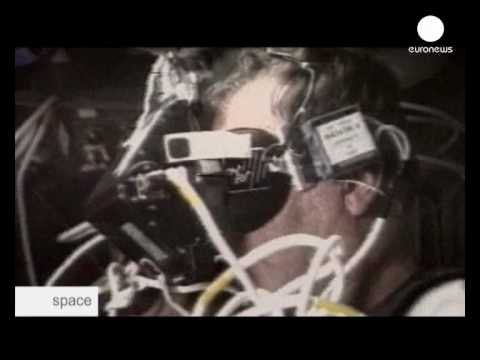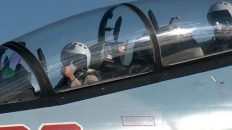A manned space flight to Mars would mean the crew being isolated from Earth for an unprecedented 18 months. To understand the true nature of this challenge, a team of international volunteers are being sealed into this research module for 520 days….
It’s the dress rehearsal at the Russian Institute for Biomedical Problems in Moscow: these are the final preparations before the full-length simulated mission to Mars begins.
Diego Urbina, ESA 520-day isolation study crew member: ”My name is Diego Urbina. I’ve just turned 27. I come from Turin, Italy. I’m Italian and Colombian. I’m an electronics engineer specialising in Space studies. And I’m part of the crew of Mars-500.”
Specially-developed space suits are one of the unique features of this international experiment which includes, for the first time, a mock-up Mars landing to the long-term crew isolation studied previously.
Diego Urbina: ”It’ll be a really claustrophobic experience, but otherwise very nice, very exciting!”
Claustrophobics would not enjoy spending 520 days (the presumed duration of a return flight to Mars) inside the air-tight research module relying on many of the same life-support systems that would be used on a real rocket to Mars.
Christer Fuglesang, Head of Science and Application Division, ESA Directorate of Human Spaceflight: “This experiment we do here is a very good way to give us ideas how we need to prepare the crews which will eventually go to Mars. And that’s really crucial, when we sent people to space – whether it’s a two weeks flight which I did twice, or if it’s half a year on a space station, or it will be one and half years to Mars. We need to have an idea of what do they need to know, so that we could prepare them.”
Out of hundreds of volunteers, a crew of six has been selected – three Russians, a Chinese and two Europeans.
Romain Charles, ESA 520-day isolation study crew member: “I’m called Romain Charles. I’m 30 years old. I’m French and I’m an engineer in the car industry.”
In the weeks before the joint experiment of IBMP and the European Space Agency starts on June 3, the crew members were trained to use the research equipment they will use during the 520-day simulated flight.
Romain Charles: “We will be do lots of experiments, some are to do with physiology, others with skills, like this one. Here I’m learning to dock a Soyuz on the International Space Station without crashing the spaceship… But the aim is, in fact, to monitor my stress-reaction to the docking, to check my concentration, and what factors play a part. That will mean they can determine what level of tiredness, or lack of competence I need, so they can stop me before I take a spaceship and crash it into the ISS… Of course here it’s not real!”
But Mars-500 is not just about testing new self-training and life support systems: it’s mainly an extreme test of human endurance – something which has been investigated by Russian biomedics since Soviet times. A manned flight to Mars was for many years a strategic goal of the Soviet Space programme, intended to reclaim the leadership in manned Space flight after the American Moon landing.
Valeriy Polyakov, Physician Cosmonaut, Longest single space flight record holder: “When we flew aboard the “Mir” station it was no bigger than this mock-up behind me: all the other modules were expected to arrive later. The intention was to assemble a prototype heavy spaceship to go to Mars. This is why the modules were autonomous. The life-support systems were capable, for example, of extracting water from atmospheric moisture, or converting human waste such as urine into oxygen and drinking water. Because a flight to Mars will be so long that you can’t rely entirely on supplies stored aboard – no rocket will be powerful enough to carry all the stocks you’ll need.”
One of the main proponents of the Soviet Mars programme, Valery Polyakov wanted to prove that it was possible to stay healthy in space long enough to make interplanetary journeys. On his second ”Mir” mission he spent 437 days in orbit, the longest space flight ever made. Five years later, the station was decommissioned and further human spaceflight continued on the ISS.
Christer Fuglesang: “What will be more difficult going to Mars are two things. First of all, we don’t have the closeness to the Earth – on the ISS you can see Earth down there, it’s so beautiful all the time. When going to Mars, you’ll soon see the Earth as just a dot in the sky, and that will make the isolation you feel much harder. And then you don’t have the same easy way to communicate – you will have a time delay which will build up over the time you fly, and will eventually reach as much as 20 minutes for a one-way signal.”
The 20 minute communication lag between earth and a space rocket will be recreated for the Mars-500 crew to add to the psychological effect of isolation – a factor that’s it’s hoped will be alleviated by the crew’s intense workload.
Valeriy Polyakov: “When they talk about psychological stress they mean it’s very difficult to stay there, in relative isolation from society, seeing nobody except your crew – facing sensory deprivation, lack of stimuli, and so on and so forth. But you have to keep in mind that you’re conducting 2-3 experiments every day, and sometimes by the evening your eyes can’t see anymore because of the microscope, and suddenly you remember that you didn’t shave, didn’t have breakfast, lunch or supper. And just imagine if such work keeps you busy every day – you won’t have any time for depression. That’s the importance of workload, and on the flight to Mars there will be enough vessel servicing and research programs to occupy the crew.”
An isolation experiment on this unprecedented scale is an exciting opportunity for researchers: international groups of them competed to study the effects of being in such an enclosed environment for such a long time.
Anatoly Grigoriev: “Lots of specialists are taking part in this study – experts in medicine, physiology, microbiology, hygiene, psychology – and other professionals, from biomedical and other related fields of knowledge. Their goal is to conduct 105 experiments within this project.”
The crew will be living under constant surveillance for the whole 18 months, via cameras and other monitoring devices.
Romain Charles: ”One of the experiments involve these watches – they record every movement throughout the day. They also record ambient light so they know if it’s day or night, if we are sleeping or not. Another interesting thing is that these watches communicate with each other – meaning they will know how close we are to other crew members.”
Another innovation is the simulated landing: halfway through the flight, the crew will split up, three of them spending a month inside the cramped landing module – with occasional exits onto the specially designed mock planetary surface.
Diego Urbina: “It’s an important part of the study because when humans get to Mars, they will have to work in space suits, and that is very difficult – you get tired, it makes you sweat, it’s hard to breathe, and difficult to move. So it is very exhausting work – and we want to simulate that.”
It is hoped that the resulting knowledge will be useful in other domains dealing with social isolation – and of course it will be invaluable for a manned journey to Mars.
Valeriy Polyakov: “When you return from a long space flight, you find that it’s people on earth who have changed psychologically while you were away. But you – you are so amazingly pure, you can’t pick a flower for the pity for it, because you saw the earth like you never saw it before. I can imagine the feelings of those flying to Mars, when they’ll watch their home planet slowly becoming small, disappearing and fading in the distance. They will return altered forever.”





